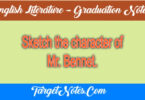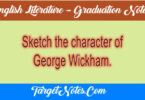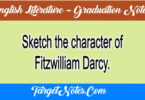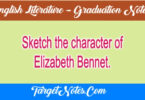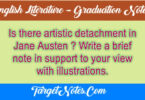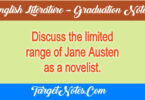
Contents
Dickens characters are both types and individuals. Discuss.
The characters of Dickens are marked by an extraordinary variety and vitality. His novel is a portrait gallery. His Micawbers, his Peggottys, his Betry Trotwoods, his Uriah Heeps, his. Stephens and Rachaels, his Sissgs and Slearys are wonderfully alive and vital. His art of characterisation suffers from short-comings. He drew characters of only from lower middle classes, or lower classes, characters from the upper classes were altogether beyond his range. His characters are sometimes denounced as unreal. They are unreal because the plot in which they are called upon to take part requires them to be so. Probable and plasusible situations were more or less beyond his range. His characters many times are placed in situations and circumstances which cannot be said to be natural by any stretch of imagination, so both the characters and the situations in which they are placed are said to be unreal.
As a true artist Dickens is aware of the fact that mere reporting is not true art and that an artist is required to select, and give his readers the inner essence, the very soul of the object described. He constantly idealises, refines and heightens reality. Reality is not falsified in his hands. He has used main devices for visualising characters. Delineation of outword peculiarities is observed. Dickens exults in portraying the external peculiarities of his characters. The externals the face, the gesture and the dress are vividly and precisely visualised. Dickens makes his characters vivid by attaching to them some tag or label. Dickens’ characters are dubbed as caricatures. There is a good deal of exaggeration in the characters of Dickens. The marked peculiarities and oddities in the dress, appearance, manner, or speech of his characters are exaggerated. His characters do not develop through circumstance. His characters are on the whole flat; they do not or change or grow psychologically under the stress of circumstance. They are the same from beginning to the end. Dickens characters are out of themselves. He cannot portray men and women of strong passions. Dickens is a failure in delineating a thoroughly black-hearted Villain. His characters are both types and individuals.
His characters nave been divided by Compton-Rickett into two classes – (1) The normal and (2) The abnormal. In the portrayal of a child as a social victim Dickens is particularly sucessful, “He is capital at a baby.” Dickens’art of characterisation, although full of some short coming, shows him as a supreme creator of characters. It is picturesque, graphic and fascinating. Dickens’ canvas is a crowded one. His characters are extremely varied and vital. His range of characterisation is a limited one. He cannot draw (a) upper class characters, (b) Intellectuals, (e) deep passionate natures, and (d) men of external grace and charm. Dickens’ characters have an air of unreality about them. Reality is constantly idealised. Dickens is good at painting the externals of character, but not the inner reality. Dickens’ characters are touched with caricature. Their peculiarities are exaggerated His characters are flat. They do not change psychologically. He is more successful with the abnormal, rather than with the normal characters.
Related Link
- Write a short note on narrative technique of a novel.
- What do you understand by Novel? What are the elements which are to considered in plot construction.
- Define Growth of Post-colonial Literature: Feminism, Post-Modernism & Important Facts
- Define The Poetic Drama & Important Facts
- What is Epic Theatre & its Important Facts?
- What is The Expressionism & Important Facts to Remember?
- What is the Theatre of the Absurd & Important Facts
- Define Drama of Ideas & Important Facts.
- Define The Problem Play & Important Facts.
Disclaimer

